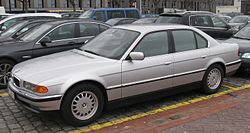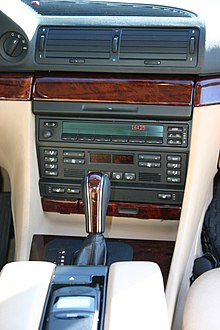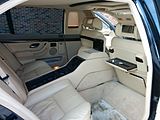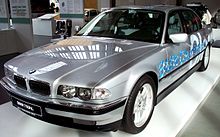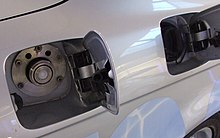BMW E38
| BMW | |
|---|---|
|
BMW 7 Series (BMW 750i, 1998-2001)
|
|
| E38 | |
| Sales designation: | 7 series |
| Production period: | 1994-2001 |
| Class : | Upper class |
| Body versions : | limousine |
| Engines: |
Gasoline engines : 2.8-5.4 liters (142-240 kW) Diesel engines : 2.5-3.9 liters (105-180 kW) |
| Length: | 4984-5374 mm |
| Width: | 1862 mm |
| Height: | 1425-1435 mm |
| Wheelbase : | 2930-3320 mm |
| Empty weight : | 1745-2260 kg |
| Previous model | BMW E32 |
| successor | BMW E65 – E68 |
The E38 series is the third generation of BMW's 7 series in the luxury class . It was introduced in June 1994 as the successor to the BMW E32 . A completely newly developed integral rear axle was used in this series . The BMW E38 was the first car from a European manufacturer to be offered with a navigation system ex works . Up to July 2001, 327,598 copies had been produced at the BMW plant in Dingolfing . The successor models were E65, E66, E67 and E68 .
Model history
Engines
The models 730i and 740i were initially offered for the market launch in June 1994. You have the eight-cylinder - V engine M60 with 3.0 and 4.0 liter displacement. While the 730i was delivered with a five-speed manual transmission as standard , the 740i received a newly developed six-speed manual transmission. The BMW 750i followed in autumn 1994, with a twelve -cylinder M73 V-engine with a displacement of 5.4 liters and an output of 240 kW (326 hp). It is linked to a five-speed automatic transmission. In autumn 1995, the 728i with the six-cylinder in - line engine M52 with 142 kW (193 hp) was introduced as the new basic engine .
In March 1996 the M60 engines were replaced by the new M62 engine series. The displacement of the 3.0 and 4.0 liter engines was increased to 3.5 liters (735i) and 4.4 liters (still referred to as 740i). The maximum torque increased from 290 Nm to 320 Nm or from 400 Nm to 420 Nm. The 735i now developed 175 kW (235 hp) instead of 160 kW (218 hp). The rated output of the 740i remained unchanged at 210 kW (286 hp). From April 1996 the 725tds was available with a six-cylinder diesel engine with swirl-chamber injection and 105 kW (143 hp).
Technology and innovation
From September 1994 a navigation system was offered as an option for the BMW E38 . It was the first car from a European manufacturer that was optionally available from the factory with a navigation system. Its 4: 3 monitor also has a TV function (analog), which could only be used when the vehicle was stationary.
Safety equipment
From September 1996, the standard equipment included side airbags for the driver and front passenger. The ITS head airbags, which were available as special equipment from June 1997, were standard equipment from September 1997. In September 1997, the standard equipment was expanded to include side airbags for the rear and in spring 1999 head airbags for the rear.
Facelift
optics
The 7 Series was optically modified in autumn 1998. The vertical struts in the BMW kidneys , the front headlights and the rear lights have now been revised in "clear glass". The side skirts were now continuous. A chrome strip on the tailgate enhances the rear view.
Technically
Engines
The variable camshaft control VANOS was introduced for the eight-cylinder engines . This increased the output of the 735i to 175 kW (238 hp) and the maximum torque to 345 Nm. The output of the 740i remained nominally unchanged at 210 kW (286 hp), and the maximum torque was increased to 440 Nm. From then on, the 735i and 740i were supplied exclusively with the five-speed automatic transmission of the type ZF 5HP24 . The six-cylinder engine of the 728i received double VANOS. New in the model 730d with a 3.0-liter six-cylinder diesel engine was common rail - direct injection . It initially developed 135 kW (184 PS) and generated a maximum torque of 410 Nm. Like the 735i and 740i, it is also linked to the 5HP24 transmission. The 725tds was only offered in a few markets from autumn 1998.
From mid-1999, the 740d with a 3.9-liter V8 biturbo diesel engine with common rail direct injection was in the range. Its output was initially specified as 175 kW (238 hp), and from the market launch it was finally 180 kW (245 hp). This made the 740d the most powerful diesel car on the market. In the spring of 2000, the output of the 730d was increased to 142 kW (193 hp), while the maximum torque rose to 430 Nm.
Furnishing
Models from April 1999 onwards were now delivered with the "shark fin antenna". There was also a revision of the switches for the front seat heating and the switch for the electric steering wheel height adjustment.
The "home lighting" function was also possible. When you got out of the car you could light the way. In June 2000 the "MK3" navigation computer was available with the 16: 9 on-board monitor. From then on, the cassette deck was located behind the device, which was to be unfolded electronically.
End of the BMW E38
The last BMW E38 rolled off the assembly line on July 27, 2001.
Body styles
Long versions
The BMW 7 Series of the E38 series was built exclusively as a four-door notchback sedan .
iL
From autumn 1994, the variants equipped with a gasoline engine were also available as a long version. The model names of the long versions contain an additional "L". The wheelbase of these vehicles is 14 centimeters longer. The space created in this way is only used by the rear passengers.
L7
From 1997 BMW produced the L7 . This is based on the 750iL and has been extended by another 25 centimeters on the B-pillar in favor of the fund. The L7 was 39 centimeters longer than the short version. The selling price was 246,000 German marks . 899 copies rolled off the line.
Security vehicles
In the second quarter of 1999, the sale of launched security vehicles 740iL Protection Line and 750iL Protection Line . They have body armor with aramid fiber mats and protective glazing. The additional protective measures brought an additional weight of approx. 145 kg. The standard equipment also includes tires with run-flat properties. The 750iL Security Line offers even greater protection .
Technical specifications
Models and engines
| model | Engine code | Displacement | cylinder | Valves | Max. power | Max. Torque | Acceleration 0-100 km / h |
Top speed | construction time | ||
|---|---|---|---|---|---|---|---|---|---|---|---|
| Petrol engines | |||||||||||
| 728i, 728iL | M52B28 | 2793 cc | R6 | 24 | 142 kW (193 hp) at 5300 rpm | 280 Nm at 3950 rpm | 8.6 s [9.6 s] | 227 km / h [225 km / h] | 1995-1998 | ||
| 142 kW (193 hp) at 5500 rpm | 280 Nm at 3500 rpm | 8.6 s [9.6 s] | 228 km / h [226 km / h] | 1998-2001 | |||||||
| 730i, 730iL | M60B30 | 2997 cc | V8 | 32 | 160 kW (218 hp) at 5800 rpm | 290 Nm at 4500 rpm | 8.3 s [9.7 s] | 235 km / h [234 km / h] | 1994-1996 | ||
| 735i, 735iL | M62B35 | 3498 cc | V8 | 32 | 173 kW (235 hp) at 5700 rpm | 320 Nm at 3300 rpm | 7.6 s [8.4 s] | 244 km / h [240 km / h] | 1996-1998 | ||
| 175 kW (238 hp) at 5800 rpm | 345 Nm at 3800 rpm | [8.2 s] | [243 km / h] | 1998-2001 | |||||||
| 740i, 740iL | M60B40 | 3982 cm³ | V8 | 32 | 210 kW (286 hp) at 5800 rpm | 400 Nm at 4500 rpm | 6.9 s [7.4 s] | 250 km / h [250 km / h] | 1994-1996 | ||
| 740i, 740iL | M62B44 | 4398 cc | V8 | 32 | 210 kW (286 hp) at 5700 rpm | 420 Nm at 3900 rpm | 6.6 s [7.0 s] | 250 km / h [250 km / h] | 1996-1998 | ||
| 210 kW (286 hp) at 5400 rpm | 440 Nm at 3600 rpm | [7.0 s] | [250 km / h] | 1998-2001 | |||||||
| 750i, 750iL | M73B54 | 5379 cc | V12 | 24 | 240 kW (326 hp) at 5000 rpm | 490 Nm at 3900 rpm | [6.6–6.8 s] | [250 km / h] | 1994-2001 | ||
| Diesel engines | |||||||||||
| 725tds | M51D25 | 2497 cc | R6 | 12 | 105 kW (143 hp) at 4600 rpm | 280 Nm at 2200 rpm | 11.5 s [12.2 s] | 206 km / h [202 km / h] | 1996-2000 | ||
| 730d | M57D30 | 2926 cc | R6 | 24 | 135 kW (184 PS) at 4000 rpm | 410 Nm at 2000-3000 rpm | [9.2 s] | [220 km / h] | 1998-2000 | ||
| 142 kW (193 hp) at 4000 rpm | 430 Nm | [8.9 s] | [220 km / h] | 2000-2001 | |||||||
| 740d | M67D40 | 3901 cc | V8 | 32 | 175 kW (238 hp) at 4000 rpm | 560 Nm | [8.4 s] | [242 km / h] | 1999-1999 | ||
| 180 kW (245 PS) at 4000 rpm | 560 Nm at 1750-2500 rpm | [8.4 s] | [242 km / h] | 1999-2001 | |||||||
| Values in square brackets apply to models with automatic transmission. | |||||||||||
| Swell: | |||||||||||
Production numbers
| model | construction time | units | source |
|---|---|---|---|
| 728i | 09 / 1995-07 / 1998 | 40,862 | |
| 728iL | 09 / 1998-07 / 2001 | 4,901 | |
| 730i | 04 / 1994-03 / 1996 | 20,213 | |
| 730iL | 04 / 1994-02 / 1996 | 2.137 | |
| 735i | 03 / 1996-07 / 2001 | 21,481 | |
| 735iL | 03 / 1996-07 / 2001 | 6,724 | |
| 740i | 04 / 1994-07 / 2001 | 129,356 | |
| 740iL | 06 / 1994-07 / 2001 | 50,933 | |
| 750i | 09 / 1994-07 / 2001 | 8,559 | |
| 750iL | k. A. | k. A. | |
| L7 | 03 / 1997-07 / 2001 | 899 | |
| 725tds | 03 / 1996-02 / 2000 | 9,053 | |
| 730d | 09 / 1998-07 / 2001 | 12,336 | |
| 740d | k. A. | k. A. | |
| 750hL | 2000 | 15th | |
| All in all | 04 / 1994-07 / 2001 | 327,598 |
Hydrogen car 750hL
On May 11, 2000, BMW presented a fleet of 15 units of the 750hL hydrogen car in Berlin. BMW described the 750hL as "the first hydrogen car in the world to be built in a small series". Its twelve-cylinder hydrogen combustion engine can run on both hydrogen and gasoline. When operated with hydrogen, it develops 150 kW (204 PS), accelerates from 0 to 100 km / h in 9.6 seconds and reaches a top speed of 226 km / h. The production of the hydrogen engine was integrated into the regular engine production at the Dingolfing plant. It differs from conventional gasoline engines essentially only in the intake tract with additional injection valves for the hydrogen. The hydrogen is stored cryogenically at a temperature of minus 253 degrees Celsius in a double-walled steel tank behind the rear seat backrests. The hydrogen tank holds 140 liters and allows an additional range of 350 kilometers. In addition, the 750hL has a fuel cell with an output of 5 kilowatts at 42 volts. This does not serve as a drive unit, but as an auxiliary power unit (APU) for powering the on-board network. During the Expo 2000 in Hanover, the vehicles were shown and also used as shuttles. From February to November 2001 the vehicles were presented as part of the “CleanEnergy WorldTour 2001” in the cities of Dubai, Brussels, Milan, Tokyo, Los Angeles and Berlin. By November 2001, the 750hL had driven over 150,000 kilometers. On the Nürburgring-Nordschleife , the 750hL achieved a lap time of 9 minutes and 53 seconds in operation with hydrogen.
BMW Alpina B12
Based on the BMW 750i and 750iL, Alpina Burkard Bovensiepen developed the B12 5.7 in 1995 and the B12 6.0 in 1999. In contrast to the BMW factory deliveries, these models are not electronically limited to a top speed of 250 km / h, but rather reach top speeds of over 280 km / h or 291 km / h. According to its own information, Alpina was the first automobile manufacturer in the world to introduce an electrically heated metal catalytic converter as standard in 1995 in the B12 5.7 .
| model | Displacement | cylinder | Max. power | Max. Torque | construction time | Base vehicle |
|---|---|---|---|---|---|---|
| B12 5.7 | 5646 cc | 12 | 285 kW (387 hp) | 560 Nm | 12/1995 to 08/1998 | 750i, 750iL |
| B12 6.0 | 5980 cc | 12 | 316 kW (430 hp) | 600 Nm | 07/1999 to 07/2001 | 750i, 750iL |
| Source: | ||||||
Existence in Germany
The stock of BMW E38 is listed according to manufacturer (HSN) and type code numbers (TSN) in the central vehicle register of the Federal Motor Transport Authority . Types with less than 100 vehicles are not shown. Until 2007, the inventory included the number of vehicles registered as well as the number of temporary shutdowns. Since 2008, the inventory has only included "flowing traffic" including the seasonal license plates.
| HSN / TSN | model | kW | 1.1.2005 | 1.1.2006 | 1.1.2008 | 1.1.2009 | 1.1.2010 | 1.1.2011 | 1.1.2012 | 1.1.2013 | 1.1.2014 | 1.1.2015 | 1.1.2016 | 1.1.2017 | 1.1.2018 | 1.1.2019 |
|---|---|---|---|---|---|---|---|---|---|---|---|---|---|---|---|---|
| 0005/543 | 730i, 730iL | 160 | 6,729 | 6,061 | 3,704 | 3,427 | 3,197 | 2,931 | 2,700 | 2,346 | 2.113 | 1,880 | 1,692 | 1,518 | 1,318 | 1,214 |
| 0005/544 | 740i, 740iL (1) | 210 | 5,895 | 5,208 | 3,557 | 3,347 | 3.119 | 2,866 | 2,611 | 2,296 | 2,040 | 1,820 | 1,634 | 1,436 | 1.312 | 1,167 |
| 0005/546 | 750i, 750iL, L7 | 240 | 5,558 | 5,219 | 3,824 | 3,570 | 3,360 | 3,075 | 2,809 | 2,517 | 2,275 | 2,050 | 1,891 | 1,761 | 1,609 | 1,470 |
| 0005/564 | 728i, 728iL | 142 | 14,401 | 13,456 | 9,968 | 9,439 | 9,023 | 8,668 | 8,126 | 7,505 | 6,895 | 6,396 | 5,902 | 5,411 | 4,939 | 4,516 |
| 0005/583 | 750iL (2) | 240 | 137 | 108 | 3 | |||||||||||
| 0005/584 | 735i, 735iL | 173 | 4,642 | 4,303 | 3,088 | 2,920 | 2,736 | 2,588 | 2,384 | 2.147 | 1,942 | 1,776 | 1.611 | 1,467 | 1,294 | 1,168 |
| 0005/585 | 740i, 740iL (3) | 210 | 8,267 | 7,639 | 5,700 | 5,436 | 5,224 | 4,956 | 4,648 | 4,322 | 3,921 | 3,661 | 3,317 | 3,072 | 2,801 | 2,588 |
| 0005/589 | 725tds | 105 | 1,451 | 1,333 | 810 | 672 | 599 | 509 | 434 | 344 | 293 | 239 | 210 | 177 | 141 | 121 |
| 0005/635 | 730d | 135 | 2,292 | 2,049 | 1,269 | 1,084 | 930 | 810 | 687 | 564 | 471 | 404 | 335 | 274 | 221 | 181 |
| 0005/636 | 740d | 175 | 149 | 123 | 13 | |||||||||||
| 0005/640 | 735i, 735iL | 175 | 2,740 | 2,545 | 1,951 | 1,851 | 1,789 | 1,729 | 1,627 | 1,505 | 1,415 | 1,323 | 1,208 | 1,118 | 1.008 | 934 |
| 0005/656 | 740d | 180 | 1.961 | 1,774 | 1,085 | 927 | 814 | 682 | 578 | 505 | 420 | 361 | 307 | 259 | 221 | 182 |
| 0005/677 | 730d | 142 | 3.128 | 2,853 | 1.924 | 1,689 | 1,508 | 1,324 | 1,153 | 1.009 | 861 | 727 | 639 | 545 | 478 | 390 |
| total | 57,350 | 52,671 | 36,880 | 34,362 | 32,299 | 30,138 | 27,757 | 25,060 | 22,646 | 20,637 | 18,746 | 17,038 | 15,342 | 13,947 | ||
| source | ||||||||||||||||
Product placement
Models of this 7 series were often used in television or film productions. A 750i, which was used in the James Bond film Tomorrow Never Dies , became particularly famous . In the film, the vehicle was controllable via a remote control; the film vehicle used was extensively converted for this purpose.
In the action film The Transporter , the main actor drives a BMW 735i. BMW made a conscious decision in favor of this model in order to promote sales figures internationally. However, a 750iL with manual gearshift was actually used for the shooting to make the scenes faster.
literature
- Eberhard Kittler : German Cars since 1990. Volume 5. Audi, BMW, Smart, VW and small series . 1st edition. Motorbuch Verlag, Stuttgart 2001, ISBN 3-613-02128-5 , p. 194-206 .
Web links
Individual evidence
- ↑ The new 7 Series from BMW: again a sovereign format. (PDF) Bayerische Motoren Werke Aktiengesellschaft, February 18, 1994, accessed on April 16, 2016 (press release 10/94).
- ↑ a b c [press kit (E38):] The new 7 Series BMW. The new BMW 7 Series. La. (PDF) Bayerische Motoren Werke Aktiengesellschaft, April 1994, accessed on April 2, 2016 (press kit).
- ↑ The new BMW twelve-cylinder 750i: wellbeing at the highest level. (PDF) Bayerische Motoren Werke Aktiengesellschaft, September 7, 1994, accessed on April 16, 2016 (press release 62/94).
- ↑ BMW 728i: Large class with six cylinders. (PDF) Bayerische Motoren Werke Aktiengesellschaft, June 6, 1995, accessed on April 16, 2016 (press release 35/95).
- ↑ Fine- tuning the BMW eight-cylinder with great effect: more torque - less consumption. (PDF) Bayerische Motoren Werke Aktiengesellschaft, December 21, 1995, accessed on April 16, 2016 (press release 81/95).
- ↑ BMW 725tds: Big class with diesel. (PDF) Bayerische Motoren Werke Aktiengesellschaft, November 22, 1995, accessed on April 16, 2016 (press release 73/95).
- ↑ It's showtime - BMW and salons in Berlin, Birmingham and Paris; CARIN makes it possible: mobility through on-board navigation. (PDF) Bayerische Motoren Werke Aktiengesellschaft, September 16, 1994, accessed on April 24, 2016 (press release 68/94).
- ↑ The essential new standard equipment at a glance. (PDF) Bayerische Motoren Werke Aktiengesellschaft, July 15, 1996, accessed on April 2, 2016 (press release 53/96).
- ↑ Extended standard equipment for BMW models, equipment measures BMW automobiles 9/97; Price list for BMW automobiles (as of September 1, 1997). (PDF) Bayerische Motoren Werke Aktiengesellschaft, July 7, 1997, accessed on April 18, 2016 (press release 39/97).
- ↑ a b c "69th Salon International de l'Automobile", Geneva: World premiere of the new BMW 3 Series Coupé and the facelift for the Z3 roadster. European premiere of the BMW X5. (PDF) Bayerische Motoren Werke Aktiengesellschaft, February 22, 1999, accessed on March 5, 2016 (press release 23/99).
- ↑ 530d and 730d August 1998, page 19
- ↑ a b BMW 530d and 730d. (PDF) Bayerische Motoren Werke Aktiengesellschaft, August 1998, accessed on April 2, 2016 (press kit).
- ↑ a b c The new BMW V8 diesel [press kit 740d (E38)]. (PDF) Bayerische Motoren Werke Aktiengesellschaft, May 1999, accessed on April 2, 2016 (press kit).
- ^ Premieres of the BMW Group in Geneva; Model update spring 2000 in the BMW range. (PDF) Bayerische Motoren Werke Aktiengesellschaft, February 18, 2000, accessed on April 24, 2016 (press release).
- ↑ BMW 7 series, model E38, E38 facelift from 1999 (www.7er.com). Retrieved January 22, 2020 .
- ↑ The last 7 Series BMW of the third generation has rolled off the assembly line. BMW Group, July 27, 2001, accessed on April 2, 2016 (press release).
- ↑ At a glance: New in the BMW automobile program '95; New prices from August 29, 1994. (PDF) Bayerische Motoren Werke Aktiengesellschaft, July 19, 1994, accessed on April 16, 2016 (press release 52/94).
- ↑ a b BMW L7 (E38). Bayerische Motoren Werke Aktiengesellschaft, accessed on April 17, 2016 .
- ↑ Operating Instructions 728i, 728iL, 735i, 735iL, 740i, 740iL, 750i, 750iL, 725tds. (PDF) Bayerische Motoren Werke Aktiengesellschaft, August 1997, p. 186 , accessed on April 24, 2016 (operating instructions).
- ↑ Fascination BMW 1999. The most characterful way to enjoy mobility. (PDF) Bayerische Motoren Werke Aktiengesellschaft, 1999, accessed on April 26, 2016 (vehicle brochure).
- ↑ Program 2001. (PDF) Bayerische Motoren Werke Aktiengesellschaft, 2001, accessed on April 24, 2016 (vehicle brochure).
- ↑ BMW 728i (E38). Bayerische Motoren Werke Aktiengesellschaft, accessed on April 17, 2016 .
- ↑ BMW 728iL (E38). Bayerische Motoren Werke Aktiengesellschaft, accessed on April 17, 2016 .
- ↑ BMW 730i (E38). Bayerische Motoren Werke Aktiengesellschaft, accessed on April 17, 2016 .
- ↑ BMW 730iL (E38). Bayerische Motoren Werke Aktiengesellschaft, accessed on April 17, 2018 .
- ↑ BMW 735i (E38). Bayerische Motoren Werke Aktiengesellschaft, accessed on April 17, 2016 .
- ↑ BMW 735iL (E38). Bayerische Motoren Werke Aktiengesellschaft, accessed on April 17, 2016 .
- ↑ BMW 740i (E38). Bayerische Motoren Werke Aktiengesellschaft, accessed on April 17, 2016 .
- ↑ BMW 740iL (E38). Bayerische Motoren Werke Aktiengesellschaft, accessed on April 17, 2016 .
- ↑ BMW 750i (E38). Bayerische Motoren Werke Aktiengesellschaft, accessed on April 17, 2016 .
- ↑ BMW 725tds (E38). Bayerische Motoren Werke Aktiengesellschaft, accessed on April 17, 2016 .
- ↑ BMW 730d (E38). Bayerische Motoren Werke Aktiengesellschaft, accessed on April 17, 2016 .
- ↑ a b c Helmut Eichsleder, Manfred Klell, Alexander Trattner: Hydrogen in vehicle technology - generation, storage, application, 4th edition, Springer, Wiesbaden 2018, ISBN 978-3-658-20446-4 . P. 227
- ↑ BMW 7 Series Sedan (E38). Bayerische Motoren Werke Aktiengesellschaft, accessed on April 17, 2016 .
- ↑ a b CleanEnergy WorldTour 2001: Finale in Berlin. BMW Group, November 8, 2001, accessed April 3, 2016 (press release).
- ↑ a b Sustainable Value Report 2001/2002. (PDF) (No longer available online.) Bayerische Motoren Werke Aktiengesellschaft, September 2001, pp. 10–13 , archived from the original on August 27, 2016 ; Retrieved April 24, 2016 . Info: The archive link was inserted automatically and has not yet been checked. Please check the original and archive link according to the instructions and then remove this notice.
- ↑ The hydrogen age has begun. (PDF) Bayerische Motoren Werke Aktiengesellschaft, May 11, 2000, accessed on April 2, 2016 (press release).
- ^ Emission Impossible. BMW Group, August 9, 2000, accessed April 25, 2016 (press release).
- ↑ a b ALPINA automobiles based on the BMW 7 Series - E38 -. ALPINA Burkard Bovensiepen GmbH + Co. KG, accessed on April 2, 2016 .
- ↑ ALPINA milestones. ALPINA Burkard Bovensiepen GmbH + Co. KG, accessed on April 2, 2016 .
- ↑ The number of passenger cars on January 1, 2005 by manufacturer and type with selected features. (PDF) In: Statistische Mitteilungen des Kraftfahrt-Bundesamt, special issue 4 for series 2, January 1, 2005. Kraftfahrt-Bundesamt, May 2005, pp. 15, 16 , archived from the original on March 18, 2006 ; accessed on January 2, 2015 .
- ↑ The number of passenger cars on January 1, 2006 by manufacturer, trade name, selected features and displacement classes. (PDF) In: Statistische Mitteilungen des Kraftfahrt-Bundesamt, special issue 4 for series 2, January 1, 2006. Kraftfahrt-Bundesamt, June 2006, p. 92 , archived from the original on October 9, 2006 ; accessed on January 2, 2015 .
- ↑ The number of passenger cars on January 1, 2008 by manufacturer, trade name, selected features and displacement classes. (PDF) In: Statistical Communications of the Federal Motor Transport Authority FZ 2, January 1, 2008. Federal Motor Transport Authority, June 2008, p. 98 , accessed on January 2, 2015 .
- ↑ The number of passenger cars on January 1, 2009 by manufacturer, trade name, selected features and cubic capacity. (PDF) In: Statistische Mitteilungen des Kraftfahrt-Bundesamt FZ 2, January 1, 2009. Kraftfahrt-Bundesamt, July 2009, p. 104 , accessed on January 2, 2015 .
- ↑ The number of passenger cars on January 1, 2010 by manufacturer, trade name, selected features and cubic capacity. (PDF) In: Statistische Mitteilungen des Kraftfahrt-Bundesamt FZ 2, January 1, 2010. Kraftfahrt-Bundesamt, July 2010, p. 104 , accessed on January 2, 2015 .
- ↑ The number of passenger cars on January 1, 2011 by manufacturer, trade name, selected features and cubic capacity. (PDF) In: Statistische Mitteilungen des Kraftfahrt-Bundesamt FZ 2, January 1, 2011. Kraftfahrt-Bundesamt, July 2011, pp. 109, 110 , accessed on January 2, 2015 .
- ↑ The number of passenger cars on January 1, 2012 by manufacturer, trade name, selected features and cubic capacity. (PDF) In: Statistische Mitteilungen des Kraftfahrt-Bundesamt FZ 2, January 1, 2012. Kraftfahrt-Bundesamt, July 2012, p. 114 , accessed on January 2, 2015 .
- ↑ Passenger car inventory on January 1, 2013 by manufacturer, trade name and selected features. (PDF) In: Statistische Mitteilungen des Kraftfahrt-Bundesamt FZ 2, January 1, 2013. Kraftfahrt-Bundesamt, July 2013, p. 26 , accessed on January 2, 2015 .
- ↑ Passenger car inventory on January 1, 2014 by manufacturer, trade name and selected features. (PDF) In: Statistische Mitteilungen des Kraftfahrt-Bundesamt FZ 2, January 1, 2014. Kraftfahrt-Bundesamt, July 2014, p. 29 , accessed on January 2, 2015 .
- ↑ Passenger car inventory on January 1, 2015 by manufacturer, trade name and selected features. (PDF) In: Statistische Mitteilungen des Kraftfahrt-Bundesamt FZ 2, January 1, 2015. Kraftfahrt-Bundesamt, July 2015, p. 29 , accessed on September 19, 2015 .
- ↑ Kraftfahrtbundesamt: Vehicle registrations (FZ) Stock of vehicles and vehicle trailers by manufacturer and trade name January 1, 2016. August 2016, accessed on December 3, 2017 .
- ↑ Kraftfahrtbundesamt: Vehicle registrations (FZ) Stock of motor vehicles and motor vehicle trailers by manufacturer and trade name January 1, 2017. August 2017, accessed on December 3, 2017 .
- ↑ Kraftfahrtbundesamt: Vehicle registrations (FZ) Inventory of motor vehicles and vehicle trailers by manufacturer and trade name January 1, 2018. August 2018, accessed on January 6, 2019 .
- ↑ Kraftfahrt-Bundesamt - list of manufacturers and type code numbers . Retrieved January 22, 2020 .
- ↑ Sebastian Viehmann: Legendary film cars: James Bond in the BMW was a taboo - ZEIT ONLINE. In: zeit.de. January 28, 2012, accessed June 11, 2018 .
- ↑ The Transporter. Retrieved June 19, 2018 .
| Timeline of the glass series models from 1955 to 1969 | |||||||||||||||||||||
|---|---|---|---|---|---|---|---|---|---|---|---|---|---|---|---|---|---|---|---|---|---|
| Type | independent (Hans Glas GmbH) | BMW | |||||||||||||||||||
| 1950s | 1960s | 1970s | |||||||||||||||||||
| 5 | 6th | 7th | 8th | 9 | 0 | 1 | 2 | 3 | 4th | 5 | 6th | 7th | 8th | 9 | 0 | 1 | 2 | 3 | 4th | ||
| Microcar | Goggomobil T | ||||||||||||||||||||
| Small car | Isar ("large Goggomobil") | ||||||||||||||||||||
| Lower middle class | 1004, 1204, 1304 | ||||||||||||||||||||
| Middle class | 1700 | 1800 SA, 2000 SA / 1804, 2004 [1] | |||||||||||||||||||
| Coupe | Goggomobil TS | ||||||||||||||||||||
| 1300 GT, 1700 GT | 1600 GT [2] | ||||||||||||||||||||
| 2600 V8, 3000 V8 | 3000 V8 [3] | ||||||||||||||||||||
| Vans | Goggomobil TL | ||||||||||||||||||||
|
|
|||||||||||||||||||||
